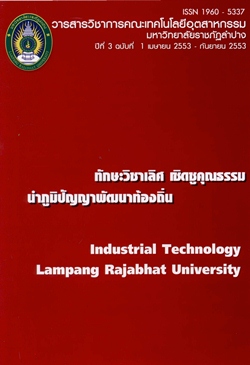การออกแบบและพัฒนาผลิตภัณฑ์เฟอร์นิเจอร์จากฟางข้าวเพื่อสร้างมูลค่าเพิ่ม
Keywords:
การออบแบบ, พัฒนา, ผลิตภัณฑ์, ฟางข้าว, สร้างมูลค่า, Design, Development, Product, Straw, Padder FiedAbstract
-
Design and Development the Furniture Product Straw from Padder Fied
The research aimed to design and develop rice straw furniture to increase the product value of rice straw. Different rice straw was assessed in terms of its physical and chemical qualities and of its market values. The data will be used to guide the design and development of rice straw furniture suitable for daily use and to pass the industrial standard, TIS. 662-2530.
The researcher studied and analyzed rice straw composition by adding different digesters to increase the quality of rice straw. These included the pulping of rice straw in Formic Acid, Acetic Acid and water as well as the grinding and mixing of rice straw with wood chip and paper. The result showed that the pulping of rice straw with a lid for hour and a half was better digested than when digested without a lid. However, there was no significant difference in solution digestion. As a result, the researcher decided to lower costs by using water to ferment rice straw overnight
After the rice straw was digested and dried, it was smoked to remove bacteria. The rice straw underwent a cementing process in which different types of cohesive agents were used (latex glue, paste glue, rubber glue, resin mixed with hardener and other types of glues mixed by the researcher). The results showed that the mixing of rice straw and resin, which was compacted in the mould and left to dry in the room temperature, yielded the best results in terms of strength and resistance. Research 'was then carried out on consumers' needs for rice straw furniture. The result showed that consumers were likely to use rice straw for chair production. The researcher used this data to design a blueprint for a model chair and then asked consumers to report satisfaction levels with the blueprint. The consumers rated the blueprint of the chair at the good level. The same blueprint was later sent to be evaluated for industrial standards. The model was granted the industrial standard, TIS. 662-2530.






